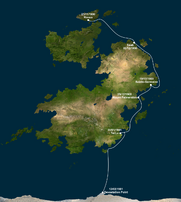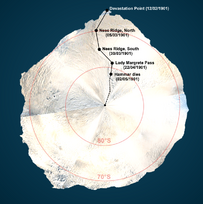1901 South Pole expedition
The 1901 South Pole expedition, also known as Hammar's expedition, was the unsuccessful attempt by Scovernois explorer Anders Søren Hammar and his crew to reach the geographic south pole by hiking across Glacia. The expedition garnered significant financial and political support, spurred on by tendencies of colonialism and imperialism amongst Euclean powers and also by scientific research groups.
Hammar and his crew onboard the ship Nordlys left Rimso on November 11, 1900, stopping for supplies at several major ports across Eastern Coius, which generated extraordinary publicity for the expedition. The crew reached Devastation Point, the northernmost point in Glacia, on February 12, 1901, almost a month later than expected due to a significant holdup in Mount Palmerston. Coupled with longer-than-expected times traversing land in Glacia meant that Hammar and his crew did not reach the 80th parallel south until late-April, and were hiking in temperatures routinely below –60°C (–76°F). These temperatures ultimately got the better of the crew, most of whom died of hypothermia and frostbite, Hammar included. Three survivors – Fred Moy, Steinar Antonsen and Leif Waag – were able to successfully navigate their way back to Devastation Point and were rescued in June.
The expedition was a catastrophic failure for Glacian exploration, with the mission's publicity resulting in a significant negative reputation for attempting to reach the South Pole. It was not until 1914 that Lyubomir Bogomilev was successfully able to reach the South Pole and return. Despite the failure of the expedition, Hammar was touted as a hero of Scovernois exploration and for the pursuit of knowledge of humanity. The Lady Margrete Pass that Hammar and his crew died in was renamed the Søren Hammar Pass in 1919, and there is a memorial at 82°W 82°S to Hammar, his crew and the 1901 expedition. After the expedition, Scovern's government attempted to claim land in Glacia between 90°W and 60°W as Hammarland, but this claim was sparsely recognised and Rimso ultimately supported the establishment of the International Condominium of Glacia in 1935.
See also
- Glacia
- Lyubomir Bogomilev, the Tengarian explorer who successfully reached the South Pole in 1914

